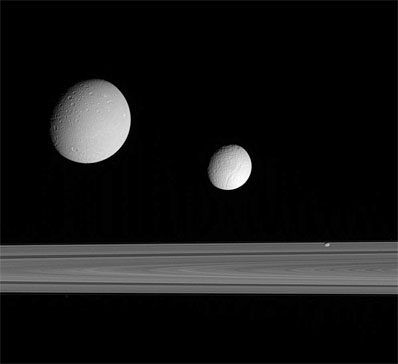
Spaceflight Now +

|

|

|

|

Premium video content for our Spaceflight Now Plus subscribers.

Griffin testifies
 NASA Administrator Mike Griffin goes before the U.S. House of Representative's Science Committee to provide an update on the moon-Mars exploration program, the future of the space shuttle and space station, possible servicing of Hubble, cost overruns on the James Webb Space Telescope and the agency's aeronautics research. NASA Administrator Mike Griffin goes before the U.S. House of Representative's Science Committee to provide an update on the moon-Mars exploration program, the future of the space shuttle and space station, possible servicing of Hubble, cost overruns on the James Webb Space Telescope and the agency's aeronautics research.

 Play video Play video

Mountains of creation
 A new image from NASA's Spitzer Space Telescope reveals billowing mountains of dust ablaze with the fires of stellar youth. The majestic infrared view from Spitzer resembles the iconic "Pillars of Creation" picture taken of the Eagle Nebula in visible light by NASA's Hubble Space Telescope. A new image from NASA's Spitzer Space Telescope reveals billowing mountains of dust ablaze with the fires of stellar youth. The majestic infrared view from Spitzer resembles the iconic "Pillars of Creation" picture taken of the Eagle Nebula in visible light by NASA's Hubble Space Telescope.

 Play video Play video

Space history: STS-51A
 This week marks the anniversary of arguably the most daring and complex space shuttle mission. The astronauts successfully launched two satellites and then recovered two others during extraordinary spacewalks by astronauts using jet-propelled backpacks and pure muscle power. This week marks the anniversary of arguably the most daring and complex space shuttle mission. The astronauts successfully launched two satellites and then recovered two others during extraordinary spacewalks by astronauts using jet-propelled backpacks and pure muscle power.

 Play video Play video

Space station EVA
 Commander Bill McArthur and flight engineer Valery Tokarev conduct a 5 1/2-hour spacewalk outside the International Space Station, installing a TV camera, doing repair chores and jettisoning a failed science probe. Commander Bill McArthur and flight engineer Valery Tokarev conduct a 5 1/2-hour spacewalk outside the International Space Station, installing a TV camera, doing repair chores and jettisoning a failed science probe.

 Play video Play video

Griffin testifies
 NASA Administrator Mike Griffin goes before the U.S. House of Representative's Science Committee to provide an update on the moon-Mars exploration program, the future of the space shuttle and space station, possible servicing of Hubble, cost overruns on the James Webb Space Telescope and the agency's aeronautics research. NASA Administrator Mike Griffin goes before the U.S. House of Representative's Science Committee to provide an update on the moon-Mars exploration program, the future of the space shuttle and space station, possible servicing of Hubble, cost overruns on the James Webb Space Telescope and the agency's aeronautics research.

 Play video Play video

The Earth from space
 Return to flight space shuttle commander Eileen Collins narrates an interesting slide show featuring some favorite photographs of Earth taken during her previous shuttle missions. Return to flight space shuttle commander Eileen Collins narrates an interesting slide show featuring some favorite photographs of Earth taken during her previous shuttle missions.

 Play video Play video

 Become a subscriber Become a subscriber
 More video More video

|

|

|

|
|

|

Cassini watches satellite trio
CASSINI PHOTO RELEASE
Posted: November 11, 2005

Credit: NASA/JPL/Space Science Institute
Download larger image version here
|
This excellent grouping of three moons -- Dione, Tethys and Pandora -- near the rings provides a sampling of the diversity of worlds that exists in Saturn's realm.
A 330-kilometer-wide (205 mile) impact basin can be seen near the bottom right on Dione (at left). Ithaca Chasma and the region imaged during the Cassini spacecraft's Sept. 24, 2005, flyby can be seen on Tethys (middle). Little Pandora makes a good showing here as well, displaying a hint of surface detail.
Tethys is on the far side of the rings in this view; Dione and Pandora are much nearer to the Cassini spacecraft.
Dione is 1,126 kilometers (700 miles) across. Tethys is 1,071 kilometers (665 miles) across and Pandora is 84 kilometers (52 miles) across.
This image was taken in visible blue light with the Cassini spacecraft narrow-angle camera at a distance of approximately 1.2 million kilometers (800,000 miles) from Saturn. The image scale is about 5 kilometers (3 miles) per pixel on Dione and Pandora and 9 kilometers (6 miles) per pixel on Tethys.
The Cassini-Huygens mission is a cooperative project of NASA, the European Space Agency and the Italian Space Agency. The Jet Propulsion Laboratory, a division of the California Institute of Technology in Pasadena, manages the mission for NASA's Science Mission Directorate, Washington, D.C. The Cassini orbiter and its two onboard cameras were designed, developed and assembled at JPL. The imaging operations center is based at the Space Science Institute in Boulder, Colo.
|

|

|

|

|



